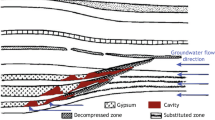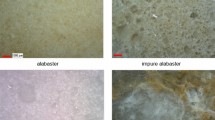Abstract
The kinetics of dissolution of different lithological varieties of gypsum was experimentally investigated at 5–25°C and P = 0.1 MPa, and a simple rate model was proposed on the basis of the sum of the rates of forward and backward reactions and proportionality to the activity product of calcium and sulfate ions. The activation energies of the forward reaction correspond to dissolution controlled by surface reaction kinetics. It was shown that the kinetic parameters of gypsum dissolution are invariant to the initial concentrations of NaCl solutions (up to 2 M). It was shown that the surface roughness factor (ξ) depends on the chemical composition of lithological varieties and the average grain size of gypsum and changes during epigenetic processes. The obtained kinetic parameters of gypsum dissolution in water will be used for the calculation of groundwater-driven mass transfer.
Similar content being viewed by others
References
A. F. Barton and N. N. Wilde, “Dissolution rates of polycrystalline samples of gypsum and orthorhombic forms of calcium sulphate by a rotating disc method,” Trans. Faraday Soc. 67, 3590–3597 (1971).
A. P. Belopol’skii, “Measurement of the dissolution rate of solids,” Izv. SFKhA 19, 395–399 (1949).
R. A. Berner, “Rate control of mineral dissolution under Earth surface conditions,” Am. J. Sci. 278 (9), 1235–1252 (1978).
A. G. Betekhtin, Mineralogy (Gosgeolizdat, Moscow, 1950) [in Russian].
L. L. Birgumshaw and A. C. Riddiford, “Transport control in heterogeneous reactions,” Chem. Soc. Quart. 6 (2), 157–182 (1952).
D. Bosbach and W. Rammensee, “In situ investigation of growth and dissolution on the (010) surface of gypsum by scanning force microscopy,” Geochim. Cosmochim. Acta 58, 843–849 (1994).
D. Buhmann and W. Dreybrodt, “Calcite dissolution kinetics in the systemH2O–CO2–CaCO3 with participation of foreign ions,” Chem. Geol. 64, 89–102 (1987).
J. Colombani, “Measurement of the pure dissolution rate constant of a mineral in water,” Geochim. Cosmochim. Acta 72, 5634–5640 (2008).
M. Davion, “Etude sur la vitesse de dissolution des sels cristallises,” Ann. Chim. Phys. 12 (8), 259–295 (1953).
B. Delmon, Introduction a la Cin@etique H@et@erog@ene (Editions Technip, Paris, 1969).
T. Dewers and M. Raines “Reply to comment on: mixed transport/reaction control of gypsum dissolution kinetics,” Chem. Geol. 168, 275–278 (2000).
W. Dibble, and W. Tiller, “Model for interface-controlled reactions,” Geochim. Cosmochim. Acta 45 (1), 79–92 (1981).
W. Dreybrodt and F. Gabrovsek, “Comments on: Mixed transport/reaction control of gypsum dissolution kinetics in aqueous solutions and initiation of gypsum karst by Michael A. Raines and Thomas A. Dewers in Chemical Geology 140, 29–48, 1997,” Chem. Geol. 168, 169–172 (2000).
C. Fan and H. H. Teng, “Surface behavior of gypsum during dissolution,” Chem. Geol. 245, 242–253 (2007).
D. A. Frank-Kamenetskii, Diffusion and Heat Transfer in Chemical Kinetics (Nauka, Moscow, 1981) [in Russian].
H. Frenkel, Z. Gerstl, and N. Alperovitch, “Exchangeinduced dissolution of gypsum and reclamation of sodic soil,” J. Soil Sci. 40, 599–611(1989).
A. N. James and A. R. Lupton, “Gypsum and anhydrite in foundations of hydraulic structures,” Geotechnique 28 (3), 249–272 (1978).
A. A. Jeschke, K. Vosbeck, and W. Dreybrodt, “Surface controlled dissolution rates of gypsum in aqueous solutions exhibit nonlinear dissolution kinetics,” Geochim. Cosmochim. Acta 65 (1), 27–34 (2001).
N. A. Karazhanov, “Kinetics of calcium sulfate dissolution,” Tr. VNIIG 36, 177–188 (1959).
V. P. Karshin and V. A. Grigoryan, “Kinetics of gypsum dissolution in water,” Zh. Fiz. Khim. 44 (5), 1356 (1970).
F. F. Laptev, “Aggressive effect of water on carbonate rocks, gypsum, and concrete,” Tr. Vsesoyuz. Kont. Spets. Geol. Kartirovaniya (Moscow—Leningrad, 1939) [in Russian].
A. C. Lasaga, “Chemical kinetics of water—rock interaction,” J. Geophys. Res. B89 (6), 4009–4025 (1984).
A. L. Lebedev and A. V. Lekhov, “Kinetics of dissolution of natural gypsum in water at 5–25°C,” Geokhimiya 6, 865–874 (1989).
A. L. Lebedev and A. V. Lekhov, “Simulation of changes in the permeability of gypsified fissured–porous rocks,” Geoekol. Inzh. Geol. Girdogeol. Geokriol. 6, 539–550 (2010).
A. L. Lebedev, A. V. Lekhov, V. N. Sokolov, and N. A. Svitoch, “Rate of gypsum leaching from the pore space of sandstones,” Geoekol. Inzh. Geol. Girdogeol. Geokriol. 5, 438–447 (2003).
O. Levenspiel, Chemical Reaction Engineering (John Wiley, New York, 1967).
V. G. Levich, Physicochemical Hydrodynamics (Akad. Nauk SSSR, Moscow, 1952) [in Russian].
S.-T. Liu and G. H. Nancollas, “The kinetics of dissolution of calcium sulfate dehydrate,” J. Inorg. Nucl. Chem. 33 (8), 2311–2316 (1971).
W. L. Marshall and R. Slusher, “Thermodynamics of calcium sulfate dihydrate in aqueous sodium chloride solutions, 0–110°,” J. Phys. Chem. 70(12), 4015–4027 (1966).
M. M. Mbogoro, M. E. Snowden, M. A. Edwards, M. Peruffo, and R. Unwin, “Intrinsic kinetics of gypsum and calcium sulfate anhydrite dissolution: surface selective studies under hydrodynamic control and the effect of additives,” J. Phys. Chem. 115, 10147–10154 (2011).
B. F. Pedersen and D. Semmingsen, “Neutron diffraction refinement of the structure of gypsum, CaSO4 · 2H2O,” Acta Crystallogr. B38 (4), 1074–1077 (1982).
M. A. Raines, and T. Dewers, “Mixed transport/reaction control of gypsum dissolution kinetics in aqueous solutions and initiation of gypsum karst,” Chem. Geol. 140, 29–48 (1997).
T. K. Sherwood, R. L. Pigford, and C. R. Wilke, Mass Transfer (McGraw-Hill Book, London, 1975).
E. L. Sjoberg and D. Rickard, “The influence of experimental design on the rate of calcite dissolution,” Geochim. Cosmochim. Acta 47, 2281–2286 (1983).
A. K. Smith and C. K. Colton, “Mass transfer to a rotating fluid,” AICHE J. 18 (5), 949–967 (1972).
V. W. Truesdale and C. Sebu, “A new analytic integration of the rate equation for batch dissolution of salts in the presence of common ion,” Aquat. Geochem. 19, 39–56 (2013).
Author information
Authors and Affiliations
Corresponding author
Additional information
Original Russian Text © A.L. Lebedev, 2015, published in Geokhimiya, 2015, No. 9, pp. 828–841.
Rights and permissions
About this article
Cite this article
Lebedev, A.L. Kinetics of gypsum dissolution in water. Geochem. Int. 53, 811–824 (2015). https://doi.org/10.1134/S0016702915070058
Received:
Accepted:
Published:
Issue Date:
DOI: https://doi.org/10.1134/S0016702915070058




